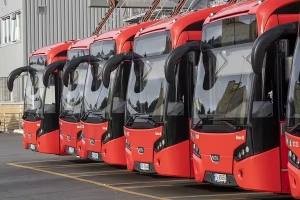As the transition to electric vehicles (EVs) accelerates, the importance of effective yard/depot management becomes increasingly evident. For companies managing electric bus and truck fleets, optimising yard operations is essential for enhancing efficiency and ensuring smooth transitions to greener alternatives. Tenix is committed to helping fleet operators navigate these challenges with innovative solutions that streamline management processes.
Understanding Yard Management
Yard management involves coordinating all necessary tasks within a fleet’s depot or facility to ensure the efficient operation of vehicles and adapt to capacity constraints. This includes:
- Preparing all vehicles for their next scheduled departure
- Monitoring the health and status of charging hardware
- Coordinating parking spaces to manage depot traffic effectively
- Optimising charging procedures and fleet activities
- Implementing necessary security measures
Effective yard management helps fleet operators maximise the use of limited space while maintaining a smooth workflow.
Key Challenges in Yard Management for Electric Fleets
- Limited Depot Space
One of the most pressing challenges for electric transit fleets is the scarcity of depot space. Electric buses and trucks require additional charging infrastructure, which complicates space management. Strategic placement of charging stations is crucial to enhance routing efficiency and reduce congestion within the depot. - Scheduled Parking Logic
With limited parking available, it’s vital to implement a schedule-based parking logic. This ensures that buses are parked according to their next departure times, minimising the risk of “blocking” other vehicles. By scheduling parking based on departure schedules, fleet operators can optimise yard space while preventing delays and maximising the flow of operations. - Charging Capacity
Another significant consideration is ensuring sufficient charging capacity at parking spots. If multiple buses share a charger, the capacity may be limited, potentially impacting the ability to complete the required charging. Effective yard management must account for the number of vehicles using a charger and ensure that each bus has access to adequate power to meet its charging needs. - Real-Time Parking Assignments
Assigning parking spots in real-time as drivers arrive at the depot can significantly enhance operational efficiency. Utilizing an app or digital signage, fleet operators can direct drivers to available parking spaces, ensuring that each vehicle is parked optimally for its next trip. This not only reduces the time spent searching for parking but also helps maintain an organized and efficient yard. - Adapting Operations
Transitioning from internal combustion engine (ICE) vehicles to electric vehicles requires significant adjustments in yard operations. Fleet managers must incorporate charging times into their schedules, ensuring that vehicles are ready for their routes. This requires careful planning and coordination with utility companies to establish a reliable charging infrastructure. - Rising Energy Costs
While electric vehicles typically have lower operating costs, managing energy expenses is essential. Tariffs can vary based on the time of day, making it crucial for fleet operators to understand their energy pricing structures and maintain efficient management of charging schedules to help mitigate these costs. - Real-Time Battery Surveillance
Implementing real-time battery surveillance adds an essential layer of efficiency for electric fleets. By continuously monitoring battery health and charge levels, fleet operators can proactively manage charging needs and prevent unexpected downtime. This capability ensures that vehicles are always ready for their next journey, optimising overall fleet performance. - Safety in Yard Management
Ensuring safety within the yard is paramount for efficient operations. Implementing clear safety protocols, such as designated walkways for workers and proper signage, helps prevent accidents. Training staff on safe vehicle handling and emergency procedures is crucial. Additionally, using technology like surveillance cameras and motion sensors can enhance security and ensure a safer working environment.
The Benefits of Yard Management Software
To address these challenges, yard management software plays a vital role in enhancing operational efficiency, including:
- Real-Time Monitoring: Yard management software provides fleet operators with real-time visibility of their vehicles and charging stations. This allows for effective coordination between yard managers and drivers, ensuring timely departures and minimising delays.
- Charger Oversight: Monitoring the status of chargers is crucial. Yard management software can alert operators to any faults or issues, helping to maintain optimal charging operations and prevent disruptions in service.
- Space Optimisation: With real-time insights into depot layouts, yard management software allows operators to efficiently manage space. This capability is especially important in facilities where space is limited, enabling better planning of vehicle movements and ensuring that charging capacity aligns with vehicle needs.
- Enhanced Route Planning: Integrating yard management with route scheduling ensures that all departing vehicles are charged and ready on time. This integration enhances punctuality and improves the overall passenger experience.
Tenix Solutions for Fleet Charging, Management, and Maintenance
At Tenix, we understand the complexities of managing electric fleets. Our solutions are designed to simplify fleet charging, management, and maintenance by providing operators with the tools necessary to enhance efficiency and reduce operational costs. Our solutions enable effective management of charging infrastructure, allowing operators to optimise energy use and ensure that electric buses and trucks are powered by clean energy sources.
Additionally, by leveraging data analytics, Tenix helps fleet operators make informed decisions regarding vehicle operations, charging schedules, and depot management. With our commitment to innovation and sustainability, Tenix provides ongoing support to help fleet operators adapt to the evolving landscape of electric transportation.
Conclusion
As the transportation industry moves towards electric vehicles, effective yard management is crucial for operational success. By implementing advanced yard management software and utilising Tenix’s innovative solutions, fleet operators can enhance efficiency, reduce costs, and support the transition to sustainable transport.
Together, we can help streamline the yard management process and drive the future of sustainable transport.


